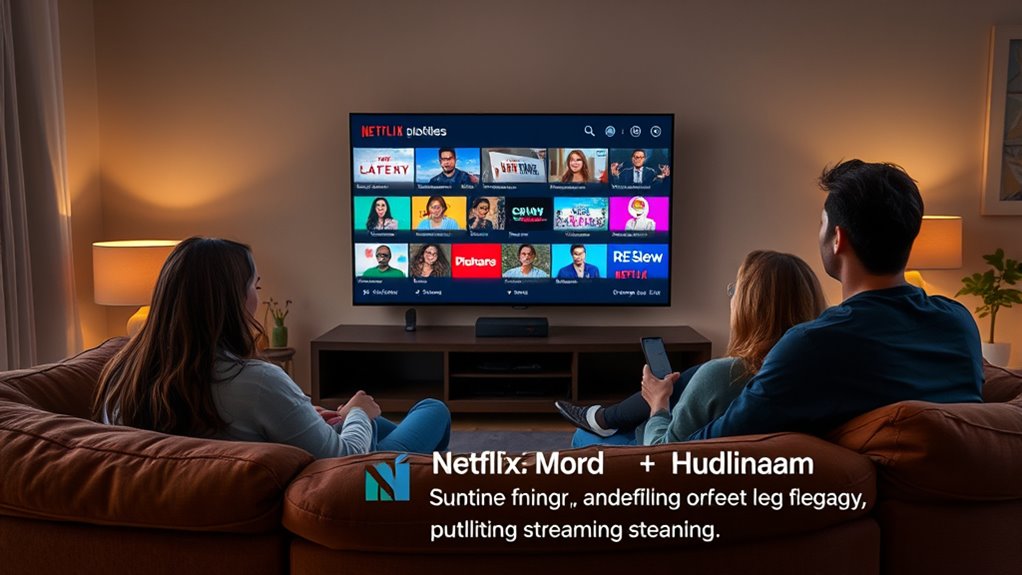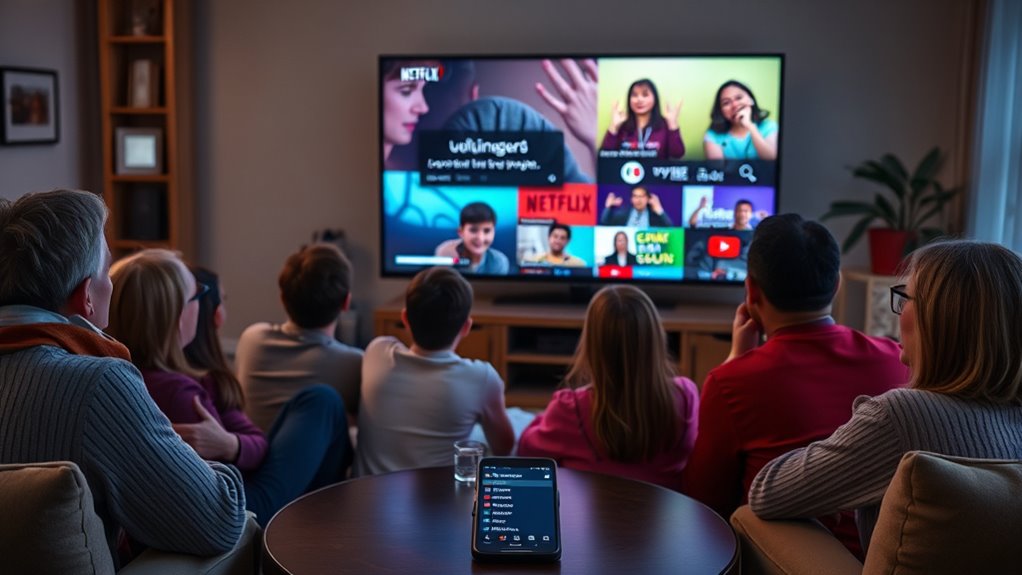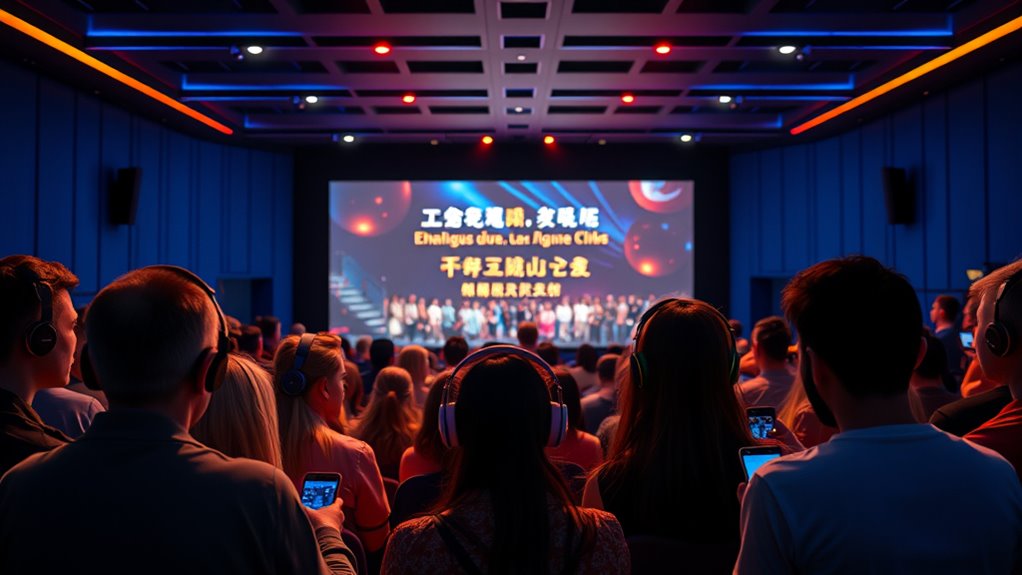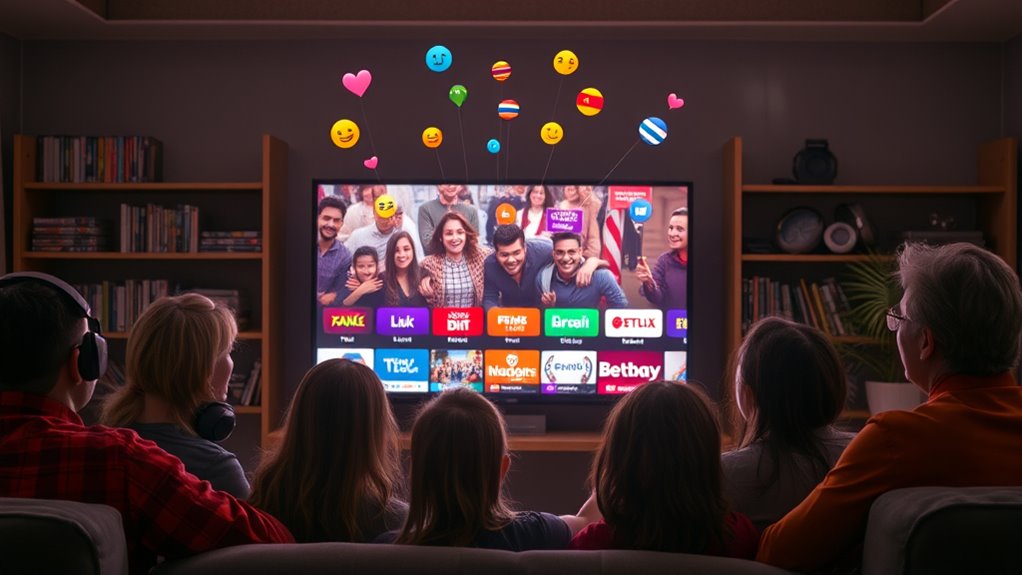Multilingual shows on Netflix and YouTube are winning audiences worldwide by offering culturally authentic content that transcends borders. By investing in localization through dubbing, subtitles, and cultural tweaks, these platforms reach diverse markets and boost engagement. Advances in technology and data-driven choices help optimize translations and regional appeal. If you want to understand how these strategies elevate global entertainment and create cross-border success, there’s more to explore beneath the surface.
Key Takeaways
- Multilingual shows attract diverse audiences worldwide, increasing engagement and global reach for platforms like Netflix and YouTube.
- Localization through dubbing and subtitles makes content accessible and culturally relevant across different regions.
- Data-driven language and regional targeting enhance viewer satisfaction and boost cross-border viewership.
- Authentic storytelling with cultural nuances fosters deeper connections and loyalty beyond native markets.
- Emerging AI technologies enable faster, high-quality localization, supporting global content expansion and audience retention.
The Growing Global Demand for Multilingual Content

The global appetite for multilingual content is rapidly expanding as audiences seek more diverse and culturally relevant entertainment options. You’re likely to notice that viewers no longer stick to their native languages; they crave authentic stories from different cultures. Streaming platforms like Netflix and YouTube have responded by investing heavily in localized content, dubbing, and subtitles. This shift allows users to access shows and videos in their preferred languages, increasing engagement and satisfaction. As a result, multilingual content isn’t just a niche anymore — it’s a core part of global streaming strategies. You can see this demand reflected in rising viewer hours, expanded international subscriber bases, and higher revenues from diverse language markets. The future of entertainment undeniably hinges on embracing this multilingual, cross-cultural trend, and incorporating high-quality audio and visual experiences will further enhance viewer immersion.
How Netflix Is Leading in Multilingual Streaming Strategies

Netflix sets the pace in multilingual streaming by investing heavily in diverse language content and innovative localization strategies. This approach helps you reach global audiences effectively. Here are four ways Netflix leads:
Netflix leads in multilingual streaming through strategic localization and diverse language content.
- Offers dubbing in 34 languages and subtitles in up to 37, expanding accessibility.
- Invests 25-35% annually in dubbing, surpassing competitors like Disney+.
- Produces nearly half of its U.S. content as non-English, reflecting commitment to diversity.
- Prioritizes data-driven language choices based on market potential, content fit, and audience interest.
- The company’s focus on essential oils for diverse needs demonstrates its commitment to comprehensive content localization and audience engagement.
This strategy boosts engagement and retention, driving international growth. By leveraging advanced localization and targeted language investments, Netflix solidifies its position as a leader in multilingual streaming, making content accessible and appealing across cultural boundaries.
YouTube’s Multilingual Audience and Content Localization Trends

Have you noticed how YouTube’s global reach is driven by its diverse multilingual audience? This diversity pushes creators to adopt multilingual strategies like subtitles, metadata translation, and native dubbing. Languages like Spanish, Hindi, and German generate high engagement and revenue, especially with region-specific localization. YouTube’s focus on optimizing content for different markets boosts viewer retention and monetization. To illustrate, consider this table:
| Language | Localization Focus | Market Impact |
|---|---|---|
| Spanish | Metadata translation, subtitles | High CPM, subscriber growth |
| Hindi | Native dubbing, culturally relevant content | Increased engagement, revenue |
| German | Formal tone, precise terminology | Authenticity, viewer loyalty |
Additionally, employing culturally appropriate localization strategies can significantly enhance viewer trust and content effectiveness. YouTube’s localization efforts are essential for tapping into underserved markets and expanding its global footprint effectively.
Effective Localization Practices That Drive Cross-Border Engagement

Effective localization practices are essential for capturing and maintaining cross-border audiences, as they go beyond simple translation to foster genuine cultural connections. To do this effectively, consider these strategies:
- Adapt metadata and titles to reflect local idioms and preferences, making content more discoverable.
- Use native voice dubbing with regional accents to enhance authenticity and viewer trust.
- Incorporate cultural nuances, humor, and slang relevant to each market, creating a relatable experience.
- Leverage data to prioritize languages and regions with the highest engagement potential, optimizing resource allocation.
Market Opportunities and Revenue Potential in Diverse Language Markets

Diverse language markets present significant growth opportunities for streaming platforms by opening new revenue streams and expanding global reach. By localizing content through dubbing and subtitles, you can tap into underserved audiences enthusiastic for relatable stories. Markets like Latin America, India, and Southeast Asia have high viewer volumes and strong monetization potential, especially with popular languages such as Spanish, Hindi, and Portuguese. Investing in high-quality localization boosts viewer engagement, increases watch time, and drives subscription growth. Additionally, niche language markets with less competition offer you a chance to establish a foothold and build loyal audiences. As global demand for multilingual content rises, capturing these markets enhances your platform’s competitiveness and creates sustainable revenue streams across diverse regions. Recognizing the appeal of regional culinary experiences, such as those showcased in local culinary shows, can further deepen audience connection and boost content relevance in these markets.
Challenges in Scaling Multilingual Content Across Different Cultures

Scaling multilingual content across different cultures presents complex challenges that go beyond simple translation. You must consider cultural nuances, humor, and regional expressions to resonate authentically. Here are four key hurdles:
- Cultural Relevance: Ensuring content reflects local customs and values without losing its core message.
- Language Adaptation: Translating idioms, humor, and slang accurately to avoid misinterpretation.
- Voice and Dubbing: Matching tone, accents, and speech patterns to native speakers for authenticity.
- Cost and Resources: Balancing high-quality localization with budget constraints, especially for niche markets.
- Additionally, choosing appropriate materials such as eco-friendly planters can symbolize sustainable practices in different regions, enhancing cultural connection.
Overcoming these obstacles requires careful research, cultural insight, and strategic investment to truly connect with diverse audiences and avoid cultural missteps.
The Role of Technology and Data in Optimizing Language Localization

Technology and data play a crucial role in enhancing language localization efforts for streaming platforms like Netflix and YouTube. You can leverage advanced algorithms and AI to automate translation, dubbing, and subtitling processes, speeding up content adaptation for diverse markets. Data analytics helps you identify which languages and regions offer the highest engagement and revenue potential, guiding your investments in localization. By analyzing viewer behavior, preferences, and regional trends, you can tailor language options, metadata, and content recommendations to boost retention and satisfaction. Machine learning models also improve auto-dubbing and subtitle accuracy over time, ensuring authentic cultural nuances. Ultimately, integrating technology and data allows you to optimize localization strategies, expand global reach, and deliver personalized, culturally relevant content more efficiently. Understanding regional viewing hours can further refine scheduling and content release times to maximize audience engagement.
Future Trends Shaping Multilingual Entertainment on Streaming Platforms

As streaming platforms continue to innovate, emerging trends are set to transform how multilingual entertainment reaches global audiences. You’ll see a shift toward more personalized, culturally nuanced content tailored through advanced AI tools. To stay ahead, consider these key trends:
- Increased use of AI-powered dubbing and subtitles for faster, more accurate localization.
- Growing demand for regional storytelling that reflects local customs and dialects.
- Expansion into emerging markets in Asia, Latin America, and Africa, driven by digital growth.
- Platforms prioritizing data-driven localization, focusing on markets with high engagement and CPM potential.
- The integration of spoiled or spoiled-looking content analysis tools to ensure quality and authenticity in translated media.
These trends will make multilingual content more accessible, authentic, and targeted. As a result, your audience will experience richer, more relevant stories that foster global loyalty and boost engagement.
Frequently Asked Questions
How Do Localization Costs Impact Netflix and Youtube’s Multilingual Strategies?
Localization costs profoundly influence Netflix and YouTube’s multilingual strategies by affecting budget allocation and content expansion plans. You’re likely to see a focus on high-ROI markets, prioritizing languages with strong viewer engagement and revenue potential. You’ll need to balance quality investments in dubbing and subtitling with expected audience size, ensuring costs don’t outweigh benefits. Strategic testing and data-driven decisions help optimize localization investments, maximizing reach while controlling expenses.
What Metrics Are Best for Measuring Cross-Border Success of Multilingual Content?
You should focus on metrics like viewer engagement, such as watch time and completion rates, to gauge cross-border success. Subscriber growth in targeted regions, especially after localization efforts, indicates effectiveness. Additionally, track regional revenue, CPM rates, and retention rates. Social shares and comments can reveal audience resonance across languages. Combining these data points helps you understand how well multilingual content resonates internationally and guides future localization strategies.
How Do Cultural Nuances Influence Translation and Dubbing Choices?
Cultural nuances are the heart and soul of authentic translation and dubbing choices, shaping how viewers connect emotionally. You should tailor language, humor, and idioms to resonate locally, like a tailor fitting a suit perfectly. By respecting regional expressions, humor, and social norms, you create content that feels genuine. This deep cultural understanding transforms a simple show into a shared experience, forging lasting bonds with diverse audiences worldwide.
What Role Does AI Play in Accelerating Multilingual Content Production?
AI accelerates multilingual content production by automating tasks like translation, subtitling, and dubbing, allowing you to scale quickly without sacrificing quality. It streamlines workflows, reduces costs, and enables rapid localization updates based on viewer data. With AI-enhanced tools, you can produce accurate, culturally nuanced content faster, helping you reach global audiences more effectively and stay competitive in the fast-evolving streaming landscape.
How Can Creators Identify Emerging Language Markets for Expansion?
You can identify emerging language markets by digging into data—surprising, right? Look at viewer engagement, CPM rates, and growth trends in regions like India, Latin America, or Africa. Pay attention to popular content types and local preferences, then test with auto-dubbing or subtitles. If those markets show promising numbers, invest in native voiceovers and metadata—it’s about smartly following the numbers, not just guessing.
Conclusion
As you explore the world of multilingual shows, think of it as planting seeds in a diverse garden—you’ll reap a vibrant, global harvest. Netflix and YouTube are watering these seeds with innovative tech and localized content, turning viewers worldwide into loyal fans. Embracing this cross-border appeal isn’t just good for business; it’s a chance to connect cultures and tell stories that resonate universally. The future of entertainment is a tapestry woven from many languages—are you ready to join in?










